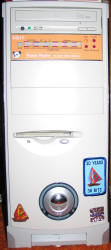
Once upon a time, Ken Harrenstein wrote a an emulator for the DEC KS10 and
KL10 processors, along with the associated peripherals. As an ex-36 bit
programmer (See What
is JFCL, anyway?) I can tell you that this was no small task,
and we're fortunate that Ken was kind enough to share his emulator, KLH10, with
the world. Mark Crispin got TOPS20 running on KLH10, and put it together
with a small Linux kernel on a bootable CD, which is available to any interested
hobbyist. To this day Mark maintains a pseudo-DECSYSTEM-20 running on PC
hardware.
The only problem with KLH10 and a PC is that it lacks the lights and switches
of the original hardware. Well, admittedly the KL and KS10 processors had
no lights and switches, but the KI and KA models did, and you'll just have to
use your imagination. In any case, after Mark bought one of the Spare Time
Gizmos PDP-8 replicas, he approached me about the possibility of creating
a pseudo front panel for KLH10. A realistic replica of a KI or KA panel
was financially, mechanically and physically beyond our means , but a simple
blinking LEDs panel was easy to do.
The result was the Panda Display Panel that you see here. The Panda
display contains 40 LEDs (because LED bars are sold in multiples of 8, not 6!)
and four discrete status LEDs. In Mark's modified version of KLH10, 36 of
the 40 LEDs emulate a KI style lights register and three of the remaining LEDs
indicate processor load. The four discrete LEDs are used to indicate
virtual Disk, Tape, and Network activity as well as the simulated processor run
state.
The Panda Display Panel is designed to replace a blank cover over a
standard 5 1/4" drive bay. The Panda Display receives power thru a standard
floppy/hard disk drive power cable and the Panda Display plugs into a standard
parallel (aka LPT) port for control and data. The display logic uses eight
standard 74HC series ICs along with one 16V8 GAL and occupies two small
PC boards. The two PC boards are designed to stack together, back to back,
and the entire assembly pretty much fits inside a blank cover for a 5 1/4"
drive bay. If you're really into blinking lights, it is possible to daisy
chain as many as four Panda Displays on the same parallel port. Each display
is individually selectable by a unique two bit address.
 The schematic and parts list for the Panda Display Panel are available
free from Spare Time Gizmos. All of the parts are readily available from
mail order sources source as Mouser,
Digi-Key and
Jameco, and it's fairly
easy to assemble for anyone who has experience building small electronic
gizmos. If you have a small, 25W soldering pencil or (better yet) a
temperature controlled soldering station and you're comfortable reading
a schematic and using it to stuff parts in a PC board then you probably
won't have any trouble with assembly.
The schematic and parts list for the Panda Display Panel are available
free from Spare Time Gizmos. All of the parts are readily available from
mail order sources source as Mouser,
Digi-Key and
Jameco, and it's fairly
easy to assemble for anyone who has experience building small electronic
gizmos. If you have a small, 25W soldering pencil or (better yet) a
temperature controlled soldering station and you're comfortable reading
a schematic and using it to stuff parts in a PC board then you probably
won't have any trouble with assembly.
If you decide to build your own, Spare Time Gizmos can sell you a set of
bare PC boards to make your life easier and we can also sell you a pre-programmed GAL. All the other parts can be ordered from
the sources given in the parts list and you should have no trouble obtaining
them. This is a low volume kit for use and we're sorry to say that we just
don't have the resources to provide a complete instruction or assembly
manual, and the schematics,
parts list and a few
assembly hints are all the documentation you'll
get. Please download and read these documents and be sure you're comfortable
with that before ordering parts.
If you don't feel comfortable building your own, then Spare Time Gizmos
will sell you a completely assembled and tested unit, ready to install in
your PC.
Please read the Spare Time Gizmos store
policies before ordering. Shipping charges shown are for the US
only - international customers please
inquire before ordering. Sales tax must be charged on all shipments to
California addresses.
 Panda Display Panel
Panda Display Panel![]()